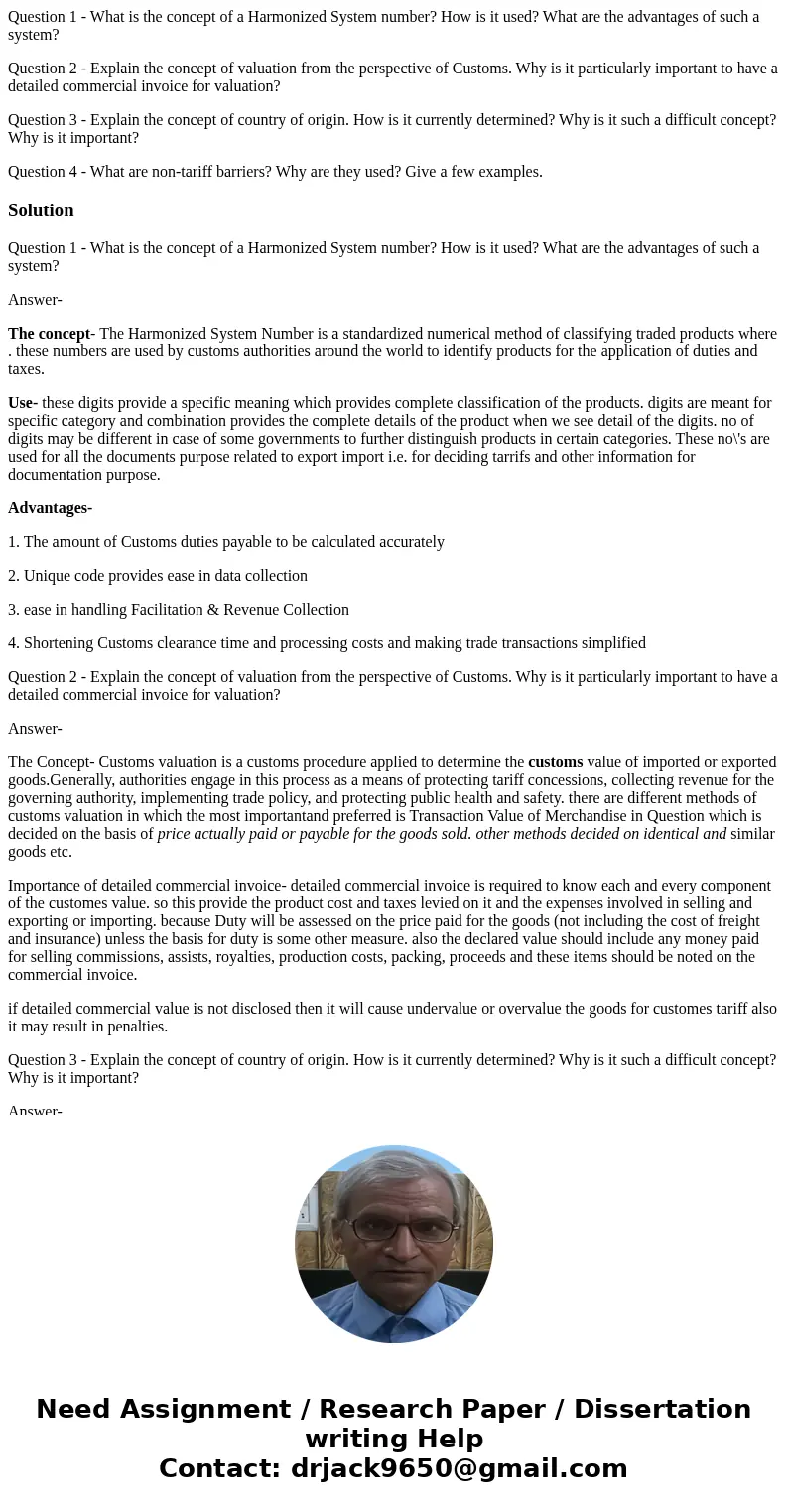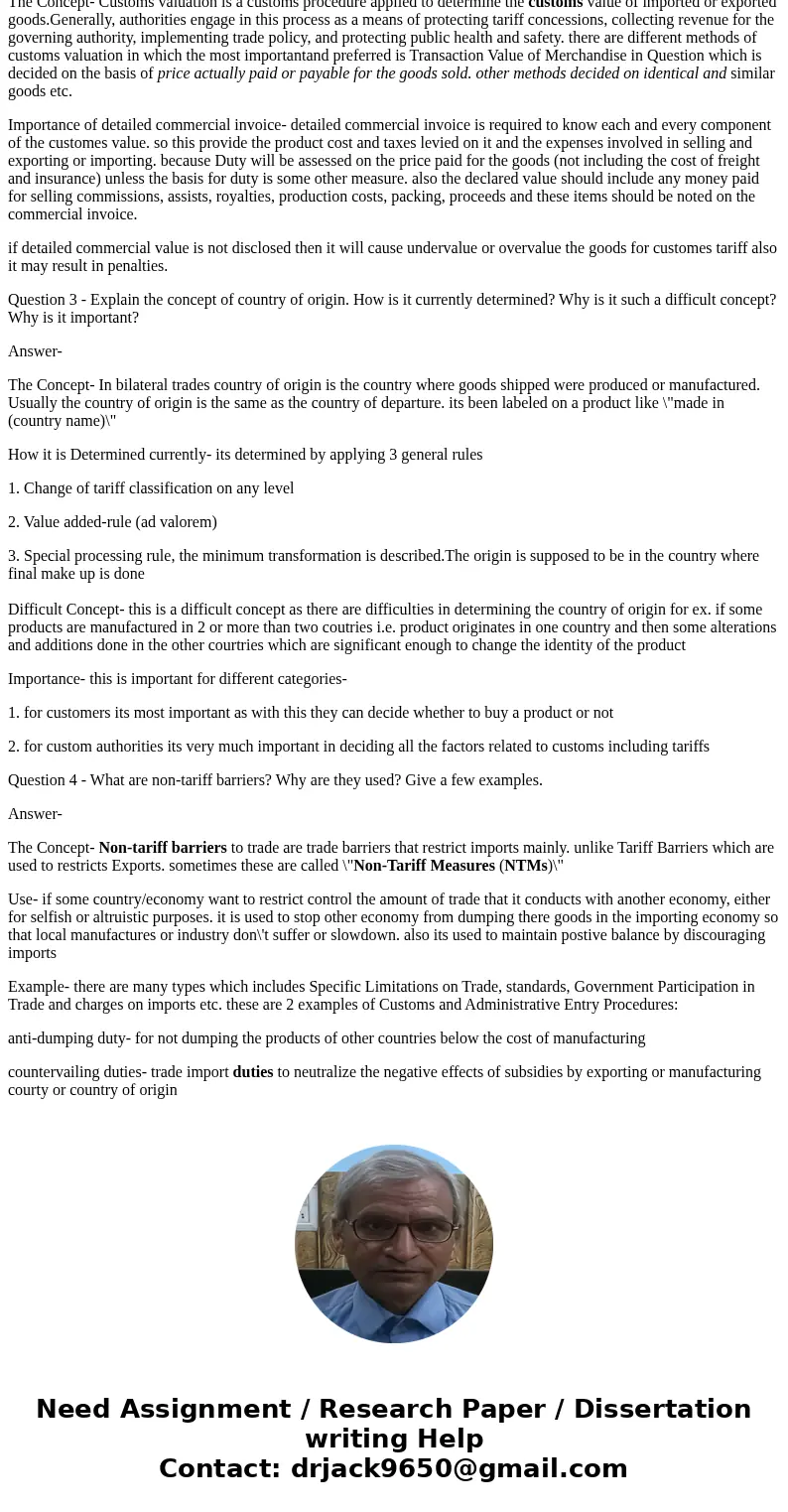Question 1 What is the concept of a Harmonized System numbe
Question 1 - What is the concept of a Harmonized System number? How is it used? What are the advantages of such a system?
Question 2 - Explain the concept of valuation from the perspective of Customs. Why is it particularly important to have a detailed commercial invoice for valuation?
Question 3 - Explain the concept of country of origin. How is it currently determined? Why is it such a difficult concept? Why is it important?
Question 4 - What are non-tariff barriers? Why are they used? Give a few examples.
Solution
Question 1 - What is the concept of a Harmonized System number? How is it used? What are the advantages of such a system?
Answer-
The concept- The Harmonized System Number is a standardized numerical method of classifying traded products where . these numbers are used by customs authorities around the world to identify products for the application of duties and taxes.
Use- these digits provide a specific meaning which provides complete classification of the products. digits are meant for specific category and combination provides the complete details of the product when we see detail of the digits. no of digits may be different in case of some governments to further distinguish products in certain categories. These no\'s are used for all the documents purpose related to export import i.e. for deciding tarrifs and other information for documentation purpose.
Advantages-
1. The amount of Customs duties payable to be calculated accurately
2. Unique code provides ease in data collection
3. ease in handling Facilitation & Revenue Collection
4. Shortening Customs clearance time and processing costs and making trade transactions simplified
Question 2 - Explain the concept of valuation from the perspective of Customs. Why is it particularly important to have a detailed commercial invoice for valuation?
Answer-
The Concept- Customs valuation is a customs procedure applied to determine the customs value of imported or exported goods.Generally, authorities engage in this process as a means of protecting tariff concessions, collecting revenue for the governing authority, implementing trade policy, and protecting public health and safety. there are different methods of customs valuation in which the most importantand preferred is Transaction Value of Merchandise in Question which is decided on the basis of price actually paid or payable for the goods sold. other methods decided on identical and similar goods etc.
Importance of detailed commercial invoice- detailed commercial invoice is required to know each and every component of the customes value. so this provide the product cost and taxes levied on it and the expenses involved in selling and exporting or importing. because Duty will be assessed on the price paid for the goods (not including the cost of freight and insurance) unless the basis for duty is some other measure. also the declared value should include any money paid for selling commissions, assists, royalties, production costs, packing, proceeds and these items should be noted on the commercial invoice.
if detailed commercial value is not disclosed then it will cause undervalue or overvalue the goods for customes tariff also it may result in penalties.
Question 3 - Explain the concept of country of origin. How is it currently determined? Why is it such a difficult concept? Why is it important?
Answer-
The Concept- In bilateral trades country of origin is the country where goods shipped were produced or manufactured. Usually the country of origin is the same as the country of departure. its been labeled on a product like \"made in (country name)\"
How it is Determined currently- its determined by applying 3 general rules
1. Change of tariff classification on any level
2. Value added-rule (ad valorem)
3. Special processing rule, the minimum transformation is described.The origin is supposed to be in the country where final make up is done
Difficult Concept- this is a difficult concept as there are difficulties in determining the country of origin for ex. if some products are manufactured in 2 or more than two coutries i.e. product originates in one country and then some alterations and additions done in the other courtries which are significant enough to change the identity of the product
Importance- this is important for different categories-
1. for customers its most important as with this they can decide whether to buy a product or not
2. for custom authorities its very much important in deciding all the factors related to customs including tariffs
Question 4 - What are non-tariff barriers? Why are they used? Give a few examples.
Answer-
The Concept- Non-tariff barriers to trade are trade barriers that restrict imports mainly. unlike Tariff Barriers which are used to restricts Exports. sometimes these are called \"Non-Tariff Measures (NTMs)\"
Use- if some country/economy want to restrict control the amount of trade that it conducts with another economy, either for selfish or altruistic purposes. it is used to stop other economy from dumping there goods in the importing economy so that local manufactures or industry don\'t suffer or slowdown. also its used to maintain postive balance by discouraging imports
Example- there are many types which includes Specific Limitations on Trade, standards, Government Participation in Trade and charges on imports etc. these are 2 examples of Customs and Administrative Entry Procedures:
anti-dumping duty- for not dumping the products of other countries below the cost of manufacturing
countervailing duties- trade import duties to neutralize the negative effects of subsidies by exporting or manufacturing courty or country of origin


 Homework Sourse
Homework Sourse